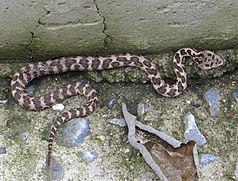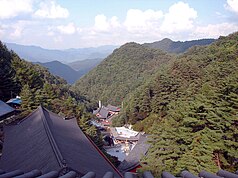Sobaeksan National Park
| Sobaeksan National Park | ||
|---|---|---|
|
|
||
| Location: | Gyeongsangbuk-do , South Korea | |
| Next city: | Yeongwol | |
| Surface: | 322.38 km² | |
| Founding: | December 14, 1984 | |
| Address: | Sobaeksan National Park Office, Address: San 86-51, Suchol-ri Punggi-eup, Yeongju Si, Gyeongsangbuk-Do | |
| Amur viper in the national park | ||
| Guinsa temple | ||
The Sobaeksan National Park ( 소백산 국립 공원 ) is located about five kilometers southeast of the city Yeongwol and ten kilometers northwest of Yeongju .
Location and geography
As the name suggests, the national park is part of the Sobaek Mountains . On its southwest border is the Expressway 55 with the Jungnyeong Tunnel and on the northeast side is the national road 88. The Sobaeksan, whose name means small white mountain , and from which the name of the mountain and the park is derived, has an altitude of 1493 m. This makes it the third highest mountain in South Korea.
Flora and fauna
So far, 2639 animal and 1067 plant species have been counted in the park, including the Megaleranthis saniculifolia , a plant of the buttercup family, and the amur viper , which only occurs in South Korea . Zacco koreanus , a fish from the carp family, is at home in the streams . In spring you can admire the azaleas bloom in the park.
Attractions
Like many other national parks, Sobaeksan also has temples. The best known is the Buseoksa ( 부석사 ) ( Temple of the Floating Rocks ), founded in 676 . There are several national treasures of South Korea as well as the oldest wooden building in South Korea, the Muryangsujeon Hall (National Treasure No. 18) and the stone lantern in front of the hall (No. 17).
Another temple complex is the Guinsa Temple. In contrast to the mostly one to two-story temple buildings in Korea, many buildings in this complex have up to five floors due to the narrowness of the valley. The complex is the spiritual center of Korean Cheontae Buddhism.
Other facilities
The Sobaeksan Optical Astronomy Observatory of the Korea Astronomy and Space Science Institute is located on the Yongwa . The observatory has a 61 cm reflector telescope . Every year 2000 guests have the opportunity to visit the observatory. Workshops for writers and artists are held in spring and autumn.
Web links
Individual evidence
- ↑ a b Sobaeksan National Park . Korea National Park Service.
- ↑ Information on the Buseoksa Temple
- ^ Sobaeksan Optical Astronomy Observatory



